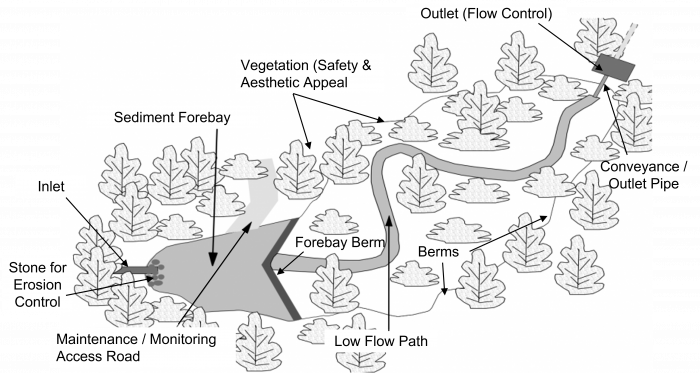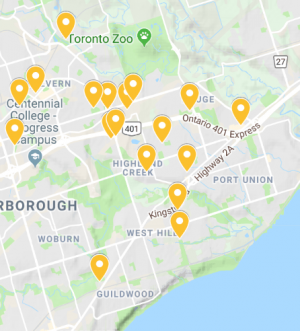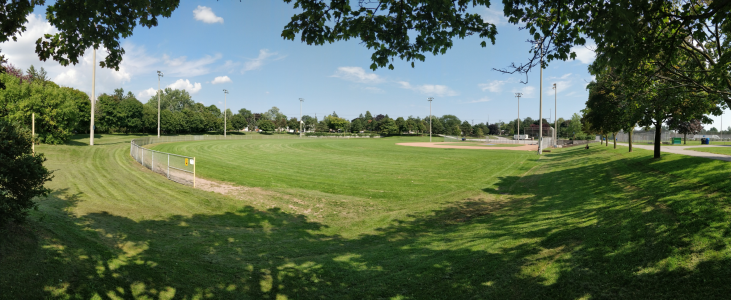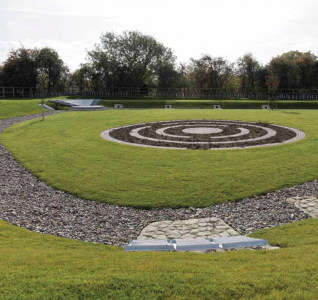Difference between revisions of "Dry ponds"
Jenny Hill (talk | contribs) m |
|||
| (12 intermediate revisions by 2 users not shown) | |||
| Line 1: | Line 1: | ||
<imagemap> | |||
File:Dry pond-labelled update.png|thumb|700 px|The following image showcases an extended detention dry pond. For more details click [https://dr6j45jk9xcmk.cloudfront.net/documents/1757/195-stormwater-planning-and-design-en.pdf here.]<ref> Ministry of the Environment. Stormwater Management Planning and Design Manual. https://dr6j45jk9xcmk.cloudfront.net/documents/1757/195-stormwater-planning-and-design-en.pdf. 2003. Accessed 3 September, 2021</ref>. <span style="color:red">''A note: The following is an "image map", feel free to explore the image with your cursor and click on highlighted labels that appear to take you to corresponding pages on the Wiki.''</span> | |||
rect 704 662 1517 837 [[Pretreatment features| Sediment Forebays]] | |||
rect 165 1106 458 1269 [[Inlets| Inlet]] | |||
rect 676 1673 930 1761 [[Inlets| Inlet]] | |||
rect 34 1630 434 1987 [[Stone| Stone Erosion Control]] | |||
rect 934 1661 1065 1848 [[Stone| Stone Erosion Control]] | |||
rect 1879 1479 2474 1626 [[Berms| Forebay Berms]] | |||
rect 2664 1535 2958 1689 [[Berms| Berms]] | |||
rect 1514 349 2406 599 [[Plant lists| Vegetation]] | |||
rect 2648 4 3565 178 [[Flow Control| Outlet]] | |||
rect 3815 325 4072 539 [[Flow Control| Outlet]] | |||
rect 3826 611 3886 480 [[Pipes| Outlet Pipe]] | |||
</imagemap> | |||
[[File:Dryponds map.PNG|thumb|link=https://goo.gl/68Ewnz|Click here to see map of Dry Ponds in Scarborough and surroundings]] | [[File:Dryponds map.PNG|thumb|link=https://goo.gl/68Ewnz|Click here to see map of Dry Ponds in Scarborough and surroundings]] | ||
See also [[Water squares]] | |||
{{TOClimit|2}} | {{TOClimit|2}} | ||
Also known as infiltration basins or detention basins (according to their features). Dry ponds are a grassed alternative to [[bioretention]] cells. This permits the landscape to be accessed and used as an amenity space. | Also known as infiltration basins or [[detention basins]] (according to their features). Dry ponds are a grassed alternative to [[bioretention]] cells. This permits the landscape to be accessed and used as an amenity space. | ||
==Overview== | ==Overview== | ||
Dry ponds are recommended as [[flood control]] structures to accommodate occasional excess overflow downstream of other structural BMPs. They should be integrated into the landscape as useful, accessible public space. | Dry ponds are recommended as [[flood control]] structures to accommodate occasional excess overflow downstream of other structural BMPs. They should be integrated into the landscape as useful, accessible public space. | ||
| Line 14: | Line 32: | ||
Dry ponds are a useful tool for managing flooding during larger storm events. They are well suited to being placed downstream of other smaller distributed BMPs for occasional backup flood protection. | Dry ponds are a useful tool for managing flooding during larger storm events. They are well suited to being placed downstream of other smaller distributed BMPs for occasional backup flood protection. | ||
Where possible they should be integrated into amenity space, given that users rarely wish to continue outdoor activities during such intense rainstorms. | Where possible they should be integrated into amenity space, given that users rarely wish to continue outdoor activities during such intense rainstorms. | ||
Compared to wet ponds “Dry ponds… …are less expensive to install, require less maintenance and may involve less liability for the communities around them.” | |||
https://www.fairfaxcounty.gov/soil-water-conservation/understanding-stormwater-ponds | |||
===Risk=== | ===Risk=== | ||
| Line 19: | Line 40: | ||
==Design== | ==Design== | ||
{|{| class="wikitable" | |||
|+Design parameters for extended detention<ref name="MOE">Ontario Ministry of Environment. (2003). Stormwater Management Planning and Design Manual. Retrieved January 15, 2017, from https://www.ontario.ca/document/stormwater-management-planning-and-design-manual/stormwater-management-plan-and-swmp-design</ref> | |||
!Element | |||
!Design Objective | |||
!Criteria | |||
|- | |||
|Drainage Area | |||
|Minimum orifice size (see [[flow control]]) | |||
|style="text-align: left|5 Ha (≥10 Ha preferred) | |||
|- | |||
|Treatment Volume | |||
|Provision of appropriate level of protection | |||
|style="text-align: left|See [[#.|below]] | |||
|- | |||
|Active Storage | |||
|Detention | |||
|style="text-align: left|[[Total Suspended solids|Suspended solids]] settling 24 hrs (48 hrs preferred) | |||
|- | |||
|Forebay | |||
|Pre-treatment | |||
|style="text-align: left| | |||
*Minimum depth: 1 m; | |||
*Sized to ensure non-erosive velocities leaving forebay; | |||
|- | |||
|Length-to-Width Ratio | |||
|Maximize flow path and minimize short-circuiting potential | |||
|style="text-align: left| | |||
*Overall: minimum 3:1; | |||
*4:1 preferred | |||
|- | |||
|Depth | |||
|Safety | |||
|style="text-align: left|Maximum 3 m | |||
|- | |||
|Side slopes (See also [[berms]]) | |||
|Safety | |||
|style="text-align: left| | |||
*4:1 average | |||
|- | |||
|Inlet | |||
|Avoid clogging/freezing | |||
|style="text-align: left| | |||
*Minimum 450 mm diameter inlet pipe; | |||
*Preferred pipe slope: > 1 %; | |||
*If submerged, obvert 150 mm below expected maximum ice depth | |||
|- | |||
|Outlet (See also [[flow control]]) | |||
|Avoid clogging/freezing | |||
|style="text-align: left| | |||
*Minimum: 450 mm diameter outlet pipe; | |||
*Preferred pipe slope: > 1 %; | |||
*If orifice control used, 75 mm diameter minimum; | |||
*Minimum 100 mm orifice preferable | |||
|- | |||
|Maintenance access | |||
|Access for backhoes or dredging equipment | |||
|style="text-align: left| | |||
*Provided to approval of Municipality; | |||
*Provision of maintenance drawdown pipe preferred | |||
|- | |||
|Buffer | |||
|Safety | |||
|style="text-align: left|Minimum 3 m above maximum water quality/erosion control water level | |||
|} | |||
The bottom of a dry pond should be flat to encourage uniform ponding and infiltration across the entire surface. Recommended tolerance on base levels 10 mm in 3m. | The bottom of a dry pond should be flat to encourage uniform ponding and infiltration across the entire surface. Recommended tolerance on base levels 10 mm in 3m. | ||
| Line 37: | Line 122: | ||
===Detention time=== | ===Detention time=== | ||
A detention time of 24 hours should be targeted in all instances. Where this necessaitates a very low outflow, a [[Flow control#Vortex valve|vortex valve]] or similar is recommended over an orifice or pipe restiction. The detention time is approximated by the drawdown time. | A detention time of 24 hours should be targeted in all instances. Where this necessaitates a very low outflow, a [[Flow control#Vortex valve|vortex valve]] or similar is recommended over an [[orifice]] or pipe restiction. The detention time is approximated by the drawdown time. | ||
The drawdown time in the pond can be estimated using the classic falling head orifice equation which assumes a constant pond surface area<ref | The drawdown time in the pond can be estimated using the classic falling head orifice equation which assumes a constant pond surface area<ref name="MOE"/>. This assumption is generally not valid, and a more accurate estimation can be made if the equation is solved as a differential equation. This is easily done if the relationship between pond surface area and pond depth is approximated using a linear regression: | ||
<math>A_o=\frac{2A_{P}}{t\ C(2g^{0.5})}\left ( h_{1}^{0.5}-h_{2}^{0.5} \right )</math> | <math>A_o=\frac{2A_{P}}{t\ C(2g^{0.5})}\left ( h_{1}^{0.5}-h_{2}^{0.5} \right )</math> | ||
| Line 71: | Line 156: | ||
==External links== | ==External links== | ||
*[https://www.edmonton.ca/residential_neighbourhoods/PDF/handout_nov_ld.pdf Edmonton Dry Ponds] | *[https://www.edmonton.ca/residential_neighbourhoods/PDF/handout_nov_ld.pdf Edmonton Dry Ponds] | ||
==To review== | |||
https://www.google.com/imgres?imgurl=http%3A%2F%2Fwww.calgary.ca%2FUEP%2FWater%2FPublishingImages%2FBraeside-Dry-Pond-610px.jpg&imgrefurl=http%3A%2F%2Fwww.calgary.ca%2FWWCDI&docid=RBtJ2qx0jhourM&tbnid=-OUrotj9LMYmfM%3A&vet=10ahUKEwjpwbyNt-bfAhXlguAKHS1pDtQQMwhjKBcwFw..i&w=610&h=299&bih=723&biw=1536&q=traplow%20stormwater&ved=0ahUKEwjpwbyNt-bfAhXlguAKHS1pDtQQMwhjKBcwFw&iact=mrc&uact=8 | |||
https://www.fairfaxcounty.gov/publicworks/sites/publicworks/files/assets/documents/drypond_1.pdf | |||
---- | ---- | ||
[[category: Modeling]] | [[category: Modeling]] | ||
Latest revision as of 20:39, 6 December 2021
See also Water squares
Also known as infiltration basins or detention basins (according to their features). Dry ponds are a grassed alternative to bioretention cells. This permits the landscape to be accessed and used as an amenity space.
Overview[edit]
Dry ponds are recommended as flood control structures to accommodate occasional excess overflow downstream of other structural BMPs. They should be integrated into the landscape as useful, accessible public space.
Dry ponds are ideal for:
- Managing infrequent extreme flow events,
- incorporating into parks and other green recreational spaces,
- distributing across a larger development site
Planning considerations[edit]
Dry ponds are a useful tool for managing flooding during larger storm events. They are well suited to being placed downstream of other smaller distributed BMPs for occasional backup flood protection. Where possible they should be integrated into amenity space, given that users rarely wish to continue outdoor activities during such intense rainstorms.
Compared to wet ponds “Dry ponds… …are less expensive to install, require less maintenance and may involve less liability for the communities around them.” https://www.fairfaxcounty.gov/soil-water-conservation/understanding-stormwater-ponds
Risk[edit]
Where temporary storage of water occurs on the surface the depth and rate of rise of the water should be sufficiently low that risks posed by the water body are minimized for site users (taking into account the temporary nature of the storage facility which will mean that the public are not accustomed to its presence). A risk assessment should be undertaken of the frequency and rate of flooding to a range of inundation depths in order that public safety is not jeopardised. [2]
Design[edit]
| Element | Design Objective | Criteria |
|---|---|---|
| Drainage Area | Minimum orifice size (see flow control) | 5 Ha (≥10 Ha preferred) |
| Treatment Volume | Provision of appropriate level of protection | See below |
| Active Storage | Detention | Suspended solids settling 24 hrs (48 hrs preferred) |
| Forebay | Pre-treatment |
|
| Length-to-Width Ratio | Maximize flow path and minimize short-circuiting potential |
|
| Depth | Safety | Maximum 3 m |
| Side slopes (See also berms) | Safety |
|
| Inlet | Avoid clogging/freezing |
|
| Outlet (See also flow control) | Avoid clogging/freezing |
|
| Maintenance access | Access for backhoes or dredging equipment |
|
| Buffer | Safety | Minimum 3 m above maximum water quality/erosion control water level |
The bottom of a dry pond should be flat to encourage uniform ponding and infiltration across the entire surface. Recommended tolerance on base levels 10 mm in 3m.
The side slopes should be no steeper than 1:3 to permit vegetation stabilization and access for maintenance and amenity. This may be relaxed where the pond area is very shallow (0.5 m). stepped or benched slopes are also a possibility, but consideration should be made of maintenance access. [2]
Volume[edit]
The surface storage volume of a dry pond (Ap) is determined:
Where:
- RVCT = Runoff volume control target (mm)
- Ac = Area of the catchment (m2)
- f' = design infiltration rate (mm/hr)
- t = time permitted for ponding to infiltrate (hrs) (typically 48 hours)
Outlet[edit]
Detention time[edit]
A detention time of 24 hours should be targeted in all instances. Where this necessaitates a very low outflow, a vortex valve or similar is recommended over an orifice or pipe restiction. The detention time is approximated by the drawdown time. The drawdown time in the pond can be estimated using the classic falling head orifice equation which assumes a constant pond surface area[3]. This assumption is generally not valid, and a more accurate estimation can be made if the equation is solved as a differential equation. This is easily done if the relationship between pond surface area and pond depth is approximated using a linear regression:
Where
- t = Drawdown time (s)
- Ap = Surface area of the pond(m2)
- C = Discharge coefficient (typically 0.63)
- Ao = Cross-sectional area of the orifice(m2)
- g = Gravitational acceleration constant (9.81 m/s2)
- h1 = Starting water elevation above the orifice (m)
- h2 = Ending water elevation above the orifice (m)
C2 slope coefficient from the area-depth linear regression C3 intercept from the area-depth linear regression
Excess flow control[edit]
- https://www.fhwa.dot.gov/engineering/hydraulics/software/hy8/
- https://www.hydrologystudio.com/no-fail-detention-pond-design/
Modeling[edit]
| Stage Storage | |
|---|---|
| Name | Important to have a unique name, to connect it with the catchment area |
| Storage type | Dry detention ponds |
| Bottom elevation (m) | This is important to correspond with other components, e.g. when the overflow is coupled to another BMP within a treatment train |
| Maximum depth (m) | |
| Lined/unlined | Unlined (ideally) |
| Underlying soil | Choose from five; sandy soils drain more quickly. |
| Evaporation factor | ? |
| Suction head (mm) | ? |
| Saturated conductivity (mm/hr) | ? |
| Initial soil moisture deficit (fraction) | ? |
| Curves | |
| The Curves table is designed to accommodate the side slopes. The top line begins at 0 m, with subsequent depths in the following lines. | |
Materials[edit]
Resilient turf grasses are particularly useful in the design of vegetated filter strips, dry ponds and enhanced grass swales. The Ministry of Transportation have standardized a number of grass mixes[4]. The 'Salt Tolerant Mix' is of particular value for low impact development applications alongside asphalt roadways and paved walkways.
| Common name | Scientific name | Proportion |
|---|---|---|
| Tall Fescue | Festuca arundinacea | 25 % |
| Fults Alkali Grass | Puccinellia distans | 20 % |
| Creeping Red Fescue | Festuca rubra | 25 % |
| Perennial ryegrass | Lolium perrenne | 20 % |
| Hard Fescue | Festuca trachyphylla | 10 % |
Gallery[edit]
Stormwater lagoon, Wilmhurst Road, Warwick. UK. Photo credit: Robin Stott
Dry polder northwest of Vincencov, Prostějov. Czech Republic. Photo credit: Jiří Komárek
External links[edit]
To review[edit]
https://www.google.com/imgres?imgurl=http%3A%2F%2Fwww.calgary.ca%2FUEP%2FWater%2FPublishingImages%2FBraeside-Dry-Pond-610px.jpg&imgrefurl=http%3A%2F%2Fwww.calgary.ca%2FWWCDI&docid=RBtJ2qx0jhourM&tbnid=-OUrotj9LMYmfM%3A&vet=10ahUKEwjpwbyNt-bfAhXlguAKHS1pDtQQMwhjKBcwFw..i&w=610&h=299&bih=723&biw=1536&q=traplow%20stormwater&ved=0ahUKEwjpwbyNt-bfAhXlguAKHS1pDtQQMwhjKBcwFw&iact=mrc&uact=8 https://www.fairfaxcounty.gov/publicworks/sites/publicworks/files/assets/documents/drypond_1.pdf
- ↑ Ministry of the Environment. Stormwater Management Planning and Design Manual. https://dr6j45jk9xcmk.cloudfront.net/documents/1757/195-stormwater-planning-and-design-en.pdf. 2003. Accessed 3 September, 2021
- ↑ Jump up to: 2.0 2.1 Ballard, B. W., Wilson, S., Udale-Clarke, H., Illman, S., Scott, T., Ashley, R., & Kellagher, R. (2015). The SuDS Manual. London.
- ↑ Jump up to: 3.0 3.1 Ontario Ministry of Environment. (2003). Stormwater Management Planning and Design Manual. Retrieved January 15, 2017, from https://www.ontario.ca/document/stormwater-management-planning-and-design-manual/stormwater-management-plan-and-swmp-design
- ↑ Ontario Provincial Standard Specification. (2014). Construction Specification and for Seed and Cover OPSS.PROV 804. Retrieved from http://www.raqsb.mto.gov.on.ca/techpubs/ops.nsf/0/3a785d2f480f9349852580820062910a/$FILE/OPSS.PROV 804 Nov2014.pdf











